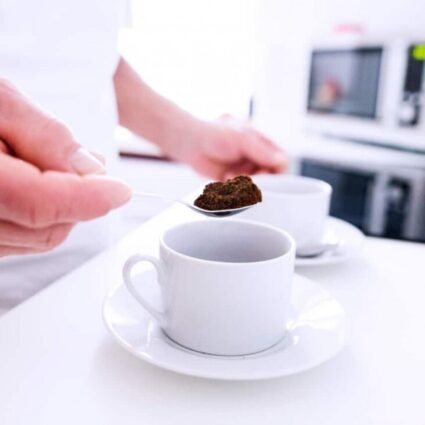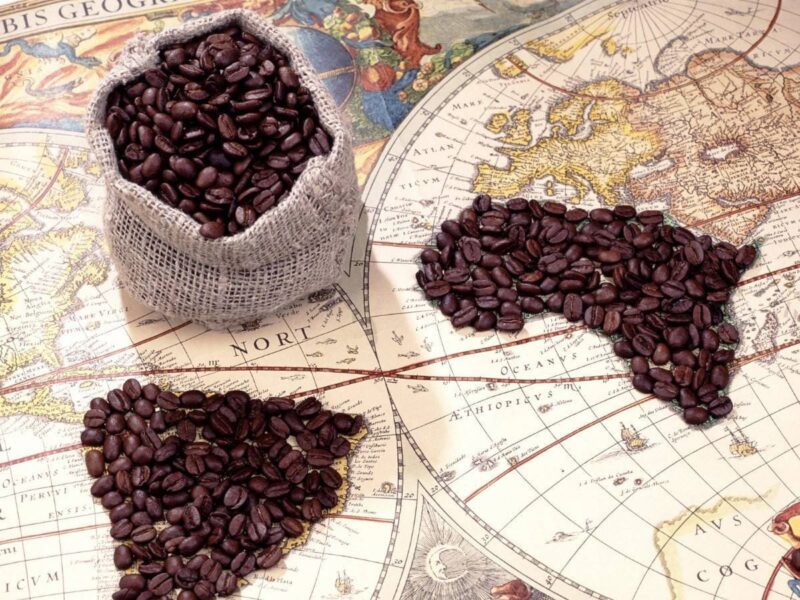Coffee is harvested from September to March in the Northern Hemisphere, and from April to August in the Southern Hemisphere. In the equatorial zone, coffee is harvested throughout the year. Coffee harvesting is a labor-intensive and expensive process that is either manual or mechanized.
Coffee, from the moment of picking, when the fruits of the coffee plant already acquire a red color like a rosehip, goes through a rather long and complicated way of processing until it reaches our cup and gives us its unique and invigorating taste and aroma.
There are 4 (four) main methods of coffee processing: dry, semi-dry, semi-wet and wet. Each of these methods has its own characteristics and disadvantages. However, before addressing these processing methods, it is worth getting acquainted with the structure of the coffee bean fruit. And so, the coffee fruit consists of 5 (five) layers. They are the skin of the coffee bean, the pulp, the protective film, the layer of silver bran, and the coffee bean, in that order. By the way, there are 2 (two) coffee beans in 1 (one) coffee cherry.
The first and oldest method of coffee processing is “Dry” or in other words, “Natural” processing. For dry processing of coffee, red (ripe) coffee beans are collected and spread on a flat surface in the open air under the direct influence of the sun’s rays. In African countries, household mesh beds are commonly used to facilitate the drying process. In Ethiopia, the homeland of coffee, for example, coffee is dried on white sheets on the roofs of houses. In order to dry evenly, the coffee is constantly stirred throughout the process. This is also very important in the sense that it allows you to avoid the formation of mold in the coffee. Depending on the time of year and the climate of the region, the coffee drying process can last from 2 (two) weeks to 2 (two) months, the average is 4 (four) weeks. During that time, under the influence of the sun, almost all (more than 90%) moisture comes out of the coffee fruit and the coffee fruit practically becomes dry. In addition, during slow drying under the sun, the sugar mass in the fruit, caramelizing, collects in the coffee beans, giving them sweet taste notes. As a result, naturally processed coffee has a sweeter taste. Then, the dried coffee beans are passed through pressing machines, deprived of the dried peel, pulp and protective film. Only the silver-coated coffee beans are then washed to remove dust and dirt and packed into 60 (sixty) kilogram bags and stockpiled. Coffee can be stored in bags for up to 2 (two) years, during which the coffee is sold to roasters and goes through the next stage of its life cycle: roasting. Due to the unique light color obtained from the silver layer, raw coffee at this stage of it’s life is also called “White Coffee”, but it is often mistakenly called “Green Coffee”, which is incorrect. White coffee is turned into green coffee only in the factory, just before roasting, with the help of dehusking machines. The reason is that without the silver bran it would not be possible to keep the coffee for so long.
Dry or Natural processing is a labor intensive process. During the entire processing period, it is necessary to manually separate spoiled and low-quality fruits from suitable products, otherwise, after complete drying, it will not be possible to separate good and bad grains, because they all look the same.
The main advantage of dry processing is that large water reserves are not required when using this method. The peculiarity is that as a result the coffee has sweet taste notes. This method of processing is mainly preferred for countries with water resource problems.
During the “Wet” or in other words, “Washed” or “Fully Washed” processing method, coffee beans are first peeled. Peel, pulp and protective film are removed. The excess mass is later used as fertilizer or fodder. As a result, only the coffee beans remain, coated with a silver layer. Then the resulting mass goes through a long-term washing phase in specially prepared concrete basins. Then the coffee is dried in special dryers for 1-2 (one to two) weeks. The resulting white coffee is again filled into bags and stockpiled.
The peculiarity of processing with this method is that due to rapid drying, the sugar in the fruit does not manage to caramelize sufficiently, and also a part of it was still removed together with the fruit pulp. As a result, the coffee gets a more sour taste. The advantages are the speed and ease of the process. The disadvantage is the use of a large amount of water. Therefore, this method is not suitable for countries with dry climates and water resource problems.
In the case of “Semi-Dry” processing, or in other words “Pulped Natural” or “Honey Processed”, the coffee beans are deprived of only the outer husk and are processed using almost the same dry processing method. As a result, the coffee is mildly sweet with a little sourness.
In the case of “Semi-Wet” processing, or in other words “Wet-Hulled” (mostly used in Indonesia), the coffee beans are deprived of the outer skin and pulp, and remain with a protective film and a silver layer. Processing is carried out using wet processing technology, and as a result, the coffee is mildly sour with a little sweetness.
And what flavor of coffee do you prefer… ?

























